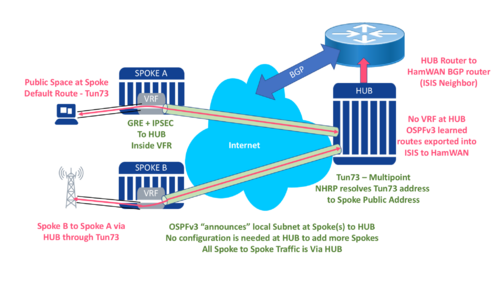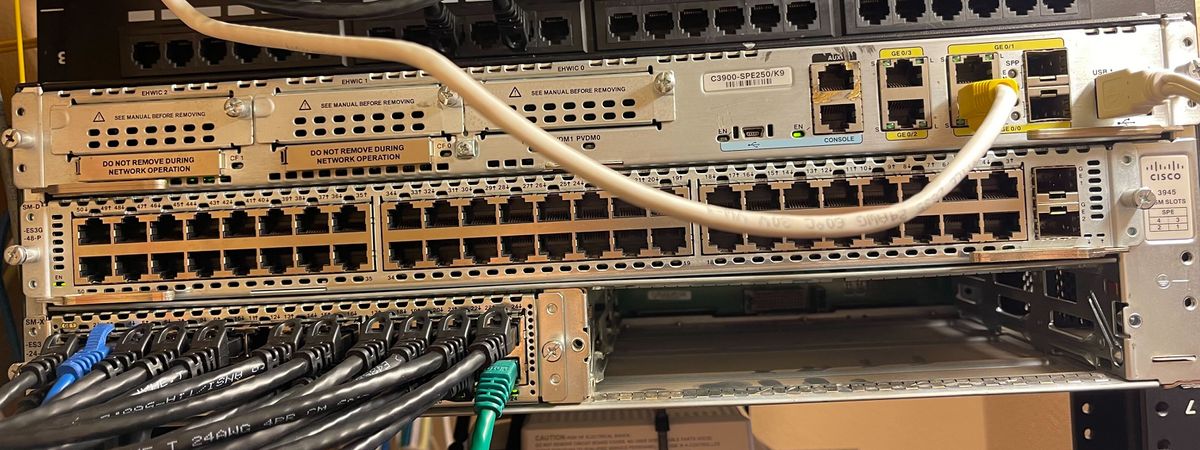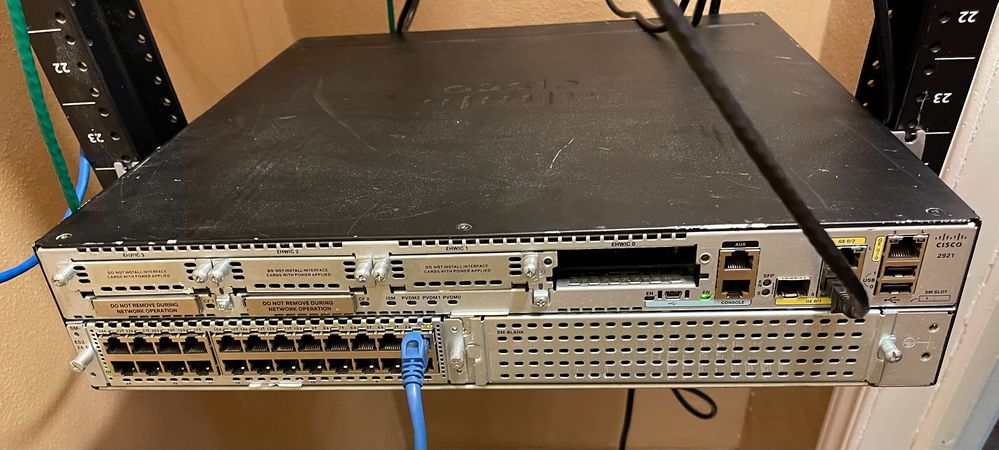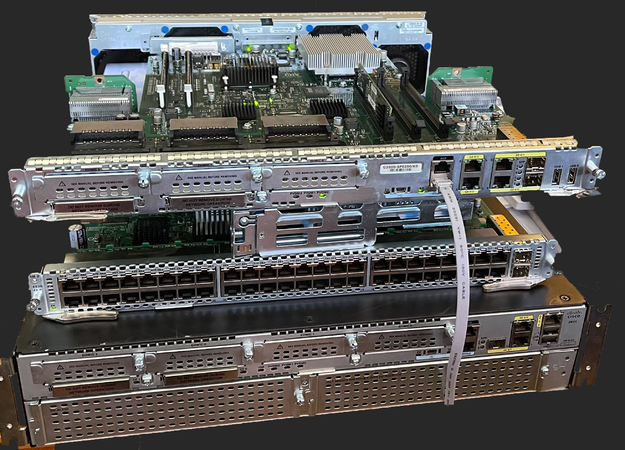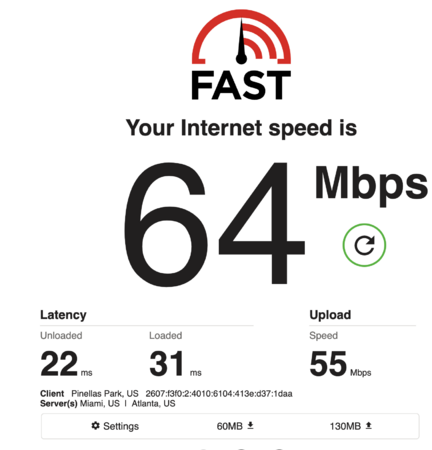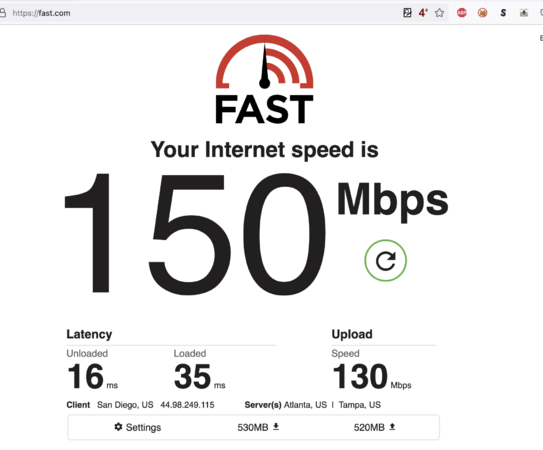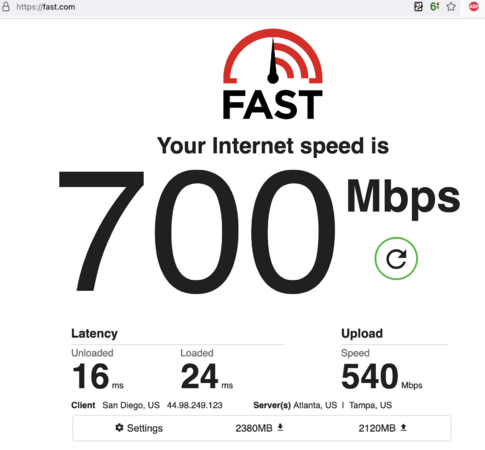HamWAN Remote Site
It's become a need for HamWAN to expand over existing internet links, as a backup and in areas we cannot hit with radio. This has shown a need at some of our other radio sites across the state, and in many cases where we can't get a good internet connection unless via restrictive NAT.
- Design Requirements:
- IPv4 and IPv6
- IPv4 DHCP and IPv6 SLAAC for clients
- Transparent routing over the underlay network (people shouldn't be able to tell it's a VPN)
- Traverse NAT, even NAT 4444!
- Local Managed Switch
- POE source on the switch
- Conserve IP space in the design
- Integrate to the existing HamWAN network
- Hub and spoke no spoke to spoke direct breakout or on demand tunneling (SDWAN)
- support for up to 10 remote locations
Contents
Thoughts on Hardware
Thought was given to this for hardware and in general we favor used routing equipment which is past it's useful life from eBay. This invariably means Cisco or lower end Juniper, but Cisco has the largest amount of gear out there.
We did configure, and deploy a network based on Mikrotik routers to test this on. While we found this would "work" it leaked information from the Mikrotik as it cannot do a VRF properly. We found a number of other issues, and I've documented some here. MT might work for you, if you're ok with it, and you can get new in the box replacements from Amazon Prime for $99.
For Cisco hardware we've settled on the Cisco 2921/51 for the Spoke routers and a 3945e for the HUB. These routers are capable of doing 300 mbit+ of traffic over the VPN, and support the routing protocols we require to do dual stack IPv4 and IPv6.
Here is a link to the hardware overview of the routers
Hub
The hub will plug into our core Juniper in Tampa via a PtP (/31) interface. This will speak ISIS, our IGP of choice for IPv4 and IPv6, and let the rest of HamWAN know as the sites come online.
We made the decision to use a multi-point GRE tunnel interface and run NHRP for the remote links. This allows us to use a /28 on the Tunnel, and support up to 13 remote locations without re-configuring. If we needed more remote sites, we can renumber or just use IPv6 :)
The one disadvantage to running multi-point GRE is we cannot run ISIS directly as ISIS doesn't use IP but rather CLNS for a transport. This means for the Tunnel interface and remote spoke sites we'll run OSPFv3 in a dual stack configuration. From the perspective of the spoke, they will get a default route and "announce" their routes to the hub.
Interconnection with HamWAN. We prefer the hub to speak ISIS to the core, and handle both address families in the same process. Our soultion to this is redistributing the learned OSPFv3 routes into the ISIS process on the Hub.
The 3945e router was chosen for the hub. The 3945e is a 3945 which had the SPE-250 processing card in it. Like all 29/3900 routers they support various service modules from ATM to Ethernet switching interfaces, and even server blades. With the right power supply the router will even support POE or POE+ depending on the switch module installed. There are several Licenses and RTU's used on this, but by default the 3945 supports SEC/K9 and will handle 225 tunnels at 150 mbit/s of throughput. The router is able to support well over 1gb/s of throughput and up to 3000 tunnels if the HSEC/K9 license is added to it. This license is locked to the CPU and must be generated from Cisco. We have aquired these licenses and are using them. The pricing is reasonable for ham radio use.
Media:ISR G2 Perfomance.pdf - This is the official Cisco Statement of performance of tthe ISR G2. Note that Cisco lies.
Miercom has a better report (but still paid for by Cisco)
FYY these are all known and the ISR/G2 routers. The next generation is the 4000 and 4400 ISR routers, which support 3 gb/s+ of crypto. As of writing they are still quite pricey on the used market.
Spoke
Our spoke site router is designed to provide us a number of Ethernet ports which serve up access to 44 net and IPv6 directly at the remote site with minimal config. We also want to support local breakout via NAT if needed too.
For HamWAN we're not concerned with encryption, so we could build a GRE tunnel without IPSEC and assuming we have an unfiltered public IPv4 at the spoke site, it would work. This would avoid the limitations of the crypto license limits as well. GRE has no ability to traverse NAT as a UDP packet, and IPSEC handles this NAT traversal quite well. Now this doesn't fix remote sites where there is layer 7 firewalling, ALG's and the like.
For IPsec we've chose to use pre-shared keys and IKEv2 vs ISAKMP as IKEv2 supports NAT traversal as via standard encapsulation of the IPSEC as UDP port 4500. It also is better in terms of us running a well known IP listener from a service denial or DOS perspective.
At the spoke we'll have a routed subnet to a VLAN interface on the router. This will bridge into the switch module and the local router will runs DHCP to hand out IPv4 and SLACC for IPv6. As this routed subnet will burn 2 IP's the management interfaces on the switch and the router, a /29 will only provide space for 4 connected devices. This may be fine at some sites, but others will need a /28 or /27. The HUB router will learn of these subnets via OSPFv3.
The routing config will be a bit complex as we want any traffic into Ethernet to not go to the default routing table. This means a VRF (or separate routing table) is needed for these interfaces. On the Spoke a VRF, HamWAN is created and the Tunnel and Vlan interface are placed inside it. The OSPFv3 process must run inside this table as well as it must not leak any routes from or into the default table on the router since the default table is how the tunnel traverses the underlay network (internet).
The decision here was made to go with the Cisco 2921 or 2951 routers. There is not much performance difference in these, but they are limited to 85mbit/s of IPSEC unless they have the HSEC/K9 license AND the ISM-VPN-29 crypto accelerator module. This is known as the "CISCO2951-HSEC+/K9" bundle. Also if you intend to run the POE switch module a special power supply "PWR-2921-51-POE" is required. This this supply supplies 48v in addition to the standard 12v and 5v voltages of the standard supply.
In testing we found the 2921 with the HSEC/K9 license would do about 150 Mbit/s of realized throughput using http://fast.com for speed tests with out the ISM-VPN-29 module. Without the HSEC/K9 license it would cap at 65 Mbit/s. Bear in mind this is traffic over the VPN connection so we expect a 20% overhead or so due to encapsulation. We also tested a 3945e as a spoke router and saw 700 mbit/s, over a 750 mbit/s PON connection, and was likely limited by it. Considering the 100-150 dollar price for a 3945e on eBay, this is great performance.
For the local switch breakout there are several options:
SM-X-ES3-24-P - Based on a 3560X switch - "SM-X-ES3-24-P: EtherSwitch SM L3 + PoEPlus + MACSec + 24 10/100/1000" SM-ES3G-24-P—24 - Based on a 3560e Switch - "SM-ES3G-24-P: EtherSwitch SM L3 + POE + 24 10/100/1000" SM-ES3-24-P—23 - Based on the 3560 - "SM-ES3G-24-P: EtherSwitch SM L2 + POE + 24 10/100/1000" SM-ES2-24-P - L2 only 2960sm based - "SM-ES2-24-P: EtherSwitch SM L2 + PoE + 23 10/100 + 1 10/100/1000"
There are other switch modules, but these are the most popular. In our case we're running the SM-ES2-24-P as we don't require layer 3 on the switch but do require POE. These are managed on their own IP and boot their own IOS. They have two virtual 1g interfaces which interconnect with the router via the backplane and trunk to the switch. This way a Vlan73 on the router will correspond to vlan 73 on the switch.
General management
We want to have some basic security and monitoring.
- SNMPv3
- SSH Key auth
- NMS
- ACL's on lines.
- population of DNS to support troubleshooting
This is reflected in the configuration below, but further setup is left to the implementation here.
Cisco has a good document on secure configuration practices that you should review.
Team CYMRU's Secure BGP Template is a worth a review too.
Configs
Hub
The is the standard Hub Config we're running with annotations on the config.
service timestamps debug datetime msec service timestamps log datetime msec service password-encryption ! #set the hostname to what you want hostname Tampa-VPN ! boot-start-marker # this is the latest code from cisco as of 7-APR-2022 boot system flash:c3900e-universalk9-mz.SPA.157-3.M8.bin boot-end-marker ! ! logging persistent # enable password here enable secret 5 $1$Rr7R$3h5Yz1xtc8Ne/eY1EHODw. ! #enable the new model for auth aaa new-model ! ! #tell the AAA to use the local user list for auth aaa authentication login default local aaa authentication login vpnclient local aaa authorization console aaa authorization config-commands aaa authorization exec default local aaa authorization network localgroups local ! aaa session-id common ! #log user failures login on-failure log login on-success log # don't look up names in DNS no ip domain lookup # the domain name you need, this is needed for SSH ip domain name tampa.flscg.org #enable CEF ip cef #enable IPv6 routing ipv6 unicast-routing ipv6 cef ! #enable CLNS for ISIS clns routing ! ! ! ! key chain ISIS_HAMWAN key 1 key-string ISIS-PAssword cts logging verbose ! # this next sets up config archiving on the router. Don't do this on anything where you can't remove the disk # First you need to mkdir flash0:/cfgs if it's not there. archive path flash0:/cfgs/config maximum 14 write-memory time-period 3600 #usernames and passwords. Note that RANCID only uses an SSH key. username bryan privilege 15 secret 5 $1$gryM$uDSpJxJrvdTLynieY/E.V/ username dd privilege 15 secret 5 $1$/v6S$0cHfkn//80wOOUF8Eg/Iy0 username rancid privilege 15 ! # now we get into the crypto # this first sets up a IKEv2 Proposal named IKEv2-VPN with AES256 and SHA512 crypto ikev2 proposal IKEv2-VPN encryption aes-cbc-256 integrity sha512 group 19 ! # This makes a IKEv2 Policy and ties the proposal into the policy. crypto ikev2 policy IKEv2-VPN-POLICY proposal IKEv2-VPN ! # This sets the PSK for the remote sites crypto ikev2 keyring HamWAN peer REMOTE-ROUTERS description REMOTE-ROUTERS # the address is all since we can't control the IP they come in from. Only if the PSK matches will they be permitted address 0.0.0.0 0.0.0.0 pre-shared-key <key here> ! # Now we make a Profile IKEv2-VPN-PROFILE and tie keyring HamWAN to it. crypto ikev2 profile IKEv2-VPN-PROFILE # this must be the Gi0/0 interface address, loopbacks will not work match address local 44.98.249.197 match identity remote address 0.0.0.0 authentication remote pre-share authentication local pre-share keyring local HamWAN ! #now attache the ike2 provite to the ipsec profile HamWAN-DMVPN crypto ipsec profile HamWAN-DMVPN set ikev2-profile IKEv2-VPN-PROFILE ! # Now into the interfaces # loop back0 is used for logging and all sourced IP's from the router. Note that v6 will be configured here too interface Loopback0 ip address 44.98.249.162 255.255.255.255 #it must patricpate in ISIS ip router isis ipv6 address 2607:F3F0:2:400F::1/128 ipv6 enable #needed for the ospfv3 process ipv6 ospf 1 area 1 #needed for ISIS clns router isis ! #this is the mac-daddy where all the magic happens, Tu73 interface Tunnel73 #the subnet chosen ip address 44.98.249.97 255.255.255.240 no ip redirects # select a smaller MTU since we're running encap. ip mtu 1400 #this is the auth "key" for NHRP ip nhrp authentication HamWAN #the NHRP Network ID for ip nhrp network-id 73 #defining the next hop server as the Gi0/0 interface ip nhrp nhs 44.98.249.97 # There is 74 bytes of IPv4 + GRE + IPSEC total, so this makes the max segment for tcp 1360. ip tcp adjust-mss 1360 # Not 100% sure this is needed as we only use OSPFv3. ip ospf network broadcast # cuz it's cisco and sh cdp neig is nice cdp enable # This is the IPv6 Address, I've cut everything from 2607:f3f0:0002:4000::/52 subnet # note how we encode the ipv4 address in the device. You could use slaac too. ipv6 address 2607:F3F0:2:4000:44:98:249:97/64 # needed to enable IPv6 ipv6 enable # same as v4 ipv6 mtu 1400 # IPv6 is 20 bytes larger than v4 ipv6 tcp adjust-mss 1340 # same as v4 ipv6 nhrp authentication HamWAN ipv6 nhrp network-id 73 # this configures OSPFv3 ospfv3 1 network broadcast #This ensures the HUB is the Designated Router, higher priority wins ospfv3 1 priority 255 # below we setup the areas for the address families in ospfv3 ospfv3 1 ipv4 area 1 ospfv3 1 ipv6 area 1 #Set the Tunnel Source tunnel source GigabitEthernet0/0 # this is letting it know it's a dmvpn and that it should use NHRP to resolve next hop tunnel mode gre multipoint # this really isn't needed and adds some over head, but I like to leave it as some basic auth # if you test without ipsec, it's nice to have tunnel key 7373 # This enables IPSEC on the interface. tunnel protection ipsec profile HamWAN-DMVPN ikev2-profile IKEv2-VPN-PROFILE ! interface GigabitEthernet0/0 # the /31 north bound to the juniper core router ip address 44.98.249.197 255.255.255.254 # we're enabling ipv4 isis on the interface ip router isis duplex auto speed auto # v6 address to the core, note the IP used here is not from the /52 subnet. ipv6 address 2607:F3F0:2:1005::2/64 # enable IPv6 AF in the ISIS on this interface ipv6 router isis # set the circuit as ISIS level 2 only isis circuit-type level-2-only # now ISIS auth on cisco is a bit fucked # cisco configures the hello and the PDU auth diferently # this command sets the hello auth, PDU is configured in the isis isis authentication mode md5 isis authentication key-chain ISIS_HAMWAN ! router ospfv3 1 #Give it a router ID of loopback 0 router-id 44.98.249.162 # base the ID of the snmp-if-index for reporting interface-id snmp-if-index # limit the queue depth to 1500 TLV's to prevent overload of signaling queue-depth update 1500 # update the reference bandwidth auto-cost reference-bandwidth 1000 ! # below is where each address family is configured address-family ipv4 unicast # we don't run this on interfaces by default passive-interface default # define the interfaces OSPFv3 runs on no passive-interface Loopback0 no passive-interface Tunnel73 # send a default IPv4 Route default-information originate always exit-address-family ! address-family ipv6 unicast # this is all the same as IPv4 passive-interface default no passive-interface Tunnel73 no passive-interface Loopback0 default-information originate always exit-address-family ! router isis # set the area 49.0001 and the NSAP address of the node net 49.0001.0440.9824.9162.00 # this tells ISIS to authenticat all PDU's, not just hellos # https://netquirkengineering.files.wordpress.com/2020/07/is-is-md5-authentication.pdf authentication mode md5 authentication key-chain ISIS_HAMWAN # use the wide metric style, it's what juniper uses by default metric-style wide # Log changes log-adjacency-changes redistribute connected # this takes anything the router learns from OSPFv3 (v4) redistribute ospfv3 1 ! # this is where ipv6 gets configured in ISIS address-family ipv6 # we're going to use both AF's in the same process multi-topology redistribute connected # this takes anything the router learns from OSPFv3 (v6) including connected routes redistribute ospf 1 include-connected exit-address-family ! # don't need support for the Sun Network Disk Protocol no ip forward-protocol nd ! # nope, not serving up http no ip http server no ip http secure-server ! # the below is how to setup ssh on the router. # the crypto key generate rsa modulus 4096 must be run once !crypto key generate rsa modulus 4096 ip ssh time-out 60 ip ssh authentication-retries 2 ip ssh version 2 # the below is config to add the keys. Note that a user name must be configured too. # note that IOS has a 250 char limit on the cli, so we break them up. ip ssh pubkey-chain username bryan key-string AAAAB3NzaC1yc2EAAAADAQABAAABAQC3ruIvMI+gYdCvOr3S5GDi4J93W3+KfePp dK8WdLzsGyq4/fl9EnI284NVxEiNPCupxen6yJ4yruu6J+TXCaBW77m2MNyV4qo5V4qxLxGU le3sq1AfmD6vFyMY6XTSY9+JI6Mu022uxixlILWiqTvKh31HkOM8Ui1Fb7wdjqMYEUa3snwX SDvQKUq0ioeEvy2EdhIinGLDG8EGSR2hmqoXu6D0cfe3/zQ1kvT4lii8j5cWjA9++Ac5tHr5 rKrAUzj0+4fPKsL5bTeT5uC0e8puWNXhgn27ecv4Bx9D+KtoTaCAx//+5Q7EPTeY3ehuyO2i K3uqH/kP4cdnCtZlm2L3 exit exit exit ip ssh pubkey-chain username rancid key-string AAAAB3NzaC1yc2EAAAADAQABAAABAQDZSbQaXcziig2UlwR5cs3ihvRIGRtl8+Cc MsgXHu3WVOt0RAt8m8egiS07BN684FazM611Y4jAN1XafYWdRNHR+8dOm77dZqsoErMynQo0 2x4nUAQUaZfRZmStYmYS0dj2wqueuKUEub29dAMfWC/rdHMI7Y7+CLXRD1W1j50SmGsKBYH2 ZWTT/UGAIQL25dYsj+rWFUk/V+Kf/oDJEBd46MpL8zVLlmL4Ft3HaFjoFasdHOf1vGvE8gAO VuQMtCRExvdTWTH3pZEg0aNBBwCkgJaxmJw+JNbYuPvd2CiKWxxJZvInmNC3U2T7Yy/1SsA1 QZvAEG4ShtbfDWYdZx8v exit exit exit ! # setup a SNMP ACL. ip access-list standard snmp-acl permit 47.206.239.202 permit 199.47.174.149 permit 44.98.0.0 0.0.255.255 ! # now one for the VTY's ip access-list extended VTY permit tcp 199.47.174.0 0.0.0.255 any permit tcp 44.98.0.0 0.0.255.255 any permit tcp host 47.206.239.202 any permit tcp host 96.254.123.27 any deny ip any any log-input ! # some basic logging to the hamwan log server logging facility user logging source-interface Loopback0 logging host 44.98.254.1 ipv6 ioam timestamp ! ! # ok this below is how we configure SNMPv3 with auth. # group HamWAN, allow it to read the v1default mibs and apply the ACL "snmp-acl" snmp-server group HamWAN v3 priv read v1default access snmp-acl # configure a user HamWANv3, with view 'HamWAN' and use sha and aes128. # Note that none of the snmp utils support 192 or 256. snmp-server user HamWANv3 HamWAN v3 auth sha HamWAN-SNMPv3-PA55 priv aes 128 HamWAN-SNMPv3-PA55 snmp-server ifindex persist snmp-server trap-source Loopback0 snmp-server source-interface informs Loopback0 ! line vty 0 4 exec-timeout 180 0 # enable the snmp acl access-class VTY in transport input all line vty 5 15 access-class VTY in transport input all ! scheduler allocate 20000 1000 # configure this router for NTP and have it function as an NTP SERVER ntp source Loopback0 ntp master ntp update-calendar ntp server 45.79.214.107 ntp server 138.236.128.36 ntp server 162.248.241.94 ntp server 172.104.193.207 ! end
Core Juniper Config
This is a config snippit of what we needed to add to our existing config.
Note the ISO MTU under the vlan 26 interface. CISCO and JUNIPER will not talk if this isn't set.
interfaces {
ge-0/0/46 {
unit 0 {
family ethernet-switching {
port-mode access;
vlan {
members CISCO-VPN;
}
}
}
}
vlan {
unit 26 {
family inet {
address 44.98.249.196/31;
}
family iso {
# holy shit this is important. CISCO and Juniper will not talk unless the MTU is set
mtu 1492;
}
family inet6 {
address 2607:f3f0:0002:1005::1/64;
}
}
}
}
protocols {
isis {
interface vlan.26;
}
}
vlans {
CISCO-VPN {
vlan-id 26;
interface {
ge-0/0/46.0;
}
l3-interface vlan.26;
}
}
Spoke
# HUB # Tun 73 - 44.98.249.98/29, 2607:F3F0:2:4000:44:98:249:97/64 # routed subnets 44.98.249.112/29 and 2607:F3F0:2:4010::/64 # Vlan73 - 44.98.249.113/29, 2607:F3F0:2:4010::1/64 # Switch Module - Vlan 73 - 44.98.249.114/29 # I'll not be commenting here on what's the same as the hub. service timestamps debug datetime msec service timestamps log datetime msec service password-encryption ! #Hostname hostname LKLDFLRXRT0 ! boot-start-marker # this is the latest stable code from Cisco as of 7-APR-2022 boot system flash:c2900-universalk9-mz.SPA.157-3.M8.bin boot-end-marker ! # This is the improtant VRF defined, and since it's both IPv4 and V6 we have to # enable both. 'ip vrf' will not work for this vrf definition HamWAN description HamWAN VRF ! address-family ipv4 exit-address-family ! address-family ipv6 exit-address-family ! enable secret 4 AbuNhklLMiNLBIJkVTLQE5Nrkq2yZUtUJsb.Jp9iAzs ! aaa new-model ! aaa authentication login default local aaa authentication login vpnclient local aaa authorization console aaa authorization config-commands aaa authorization exec default local aaa authorization network localgroups local ! aaa session-id common ! #exclude the Vlan interfaces on the router and on the switch ip dhcp excluded-address 44.98.249.113 44.98.249.114 ! # setup a dhcp pool for the routed subnet ip dhcp pool HAMWAN vrf HamWAN network 44.98.249.112 255.255.255.248 # this is the site domain name, it should match DNS domain-name lkld.flscg.org default-router 44.98.249.113 dns-server 1.1.1.1 lease 0 0 15 ! no ip domain lookup #again, should match the dns ip domain name lkld.flscg.org ip cef login on-failure log login on-success log ipv6 unicast-routing ipv6 multicast-routing ipv6 cef ! multilink bundle-name authenticated ! ! ! ! key chain ISIS_HAMWAN key 1 key-string 7 143F13063B25046B08213D3E315333170E1157197A524D55433E035A5317475A50142D6925477E5208100E0149185D4F077F69491F0A05171D0916 cts logging verbose ! # this should be added by default, but it's how you run the switch in slot 1 hw-module sm 1 ! ! ! archive path flash0:/cfgs/config maximum 14 write-memory time-period 3600 ! username bryan privilege 15 secret 5 $1$gryM$uDSpJxJrvdTLynieY/E.V/ username dd privilege 15 secret 5 $1$f2AV$7sJDI32RDPaF9bgQv6qdh0 username rancid privilege 15 ! ! crypto ikev2 proposal IKEv2-VPN encryption aes-cbc-256 integrity sha512 group 19 ! crypto ikev2 policy IKEv2-VPN-POLICY proposal IKEv2-VPN ! crypto ikev2 keyring HamWAN peer REMOTE-ROUTERS description REMOTE-ROUTERS address 44.98.249.197 pre-shared-key PSK ! ! crypto ikev2 profile IKEv2-VPN-PROFILE match identity remote address 44.98.249.197 255.255.255.255 authentication remote pre-share authentication local pre-share keyring local HamWAN ! # setup the VLAN 73 for HamWAN, this is where the routed subnets live vlan 73 name HamWAN ! crypto ipsec profile HamWAN-DMVPN set ikev2-profile IKEv2-VPN-PROFILE ! # tunnel 73, this must be in the VRF and have an IP in the same subnet as the HUB interface Tunnel73 # put this in the HamWAN VRF vrf forwarding HamWAN #IP of the tunnel ip address 44.98.249.98 255.255.255.240 ip mtu 1400 ip nhrp authentication HamWAN ip nhrp network-id 73 ip nhrp nhs 44.98.249.97 nbma 44.98.249.197 ip tcp adjust-mss 1360 cdp enable # again, for the v6 interface ipv6 address 2607:F3F0:2:4000:44:98:249:98/64 ipv6 enable ipv6 mtu 1400 ipv6 tcp adjust-mss 1340 ipv6 nhrp authentication HamWAN ipv6 nhrp network-id 73 ipv6 nhrp nhs 2607:F3F0:2:4000:44:98:249:97 nbma 44.98.249.197 ospfv3 1 network broadcast # this sets the priority to 0, meaning this will not become a DR or BDR ospfv3 1 priority 0 ospfv3 1 ipv4 area 1 ospfv3 1 ipv6 area 1 # what ever source you want. tunnel source GigabitEthernet0/1 tunnel destination 44.98.249.197 tunnel key 7373 tunnel protection ipsec profile HamWAN-DMVPN ikev2-profile IKEv2-VPN-PROFILE ! # this is the outside interface set to DHCP interface GigabitEthernet0/1 ip dhcp client default-router distance 10 ip address dhcp duplex auto speed auto ! # this is a special interface used to manage the service module interface GigabitEthernet1/0 ip address 10.0.0.1 255.255.255.252 ! # This is the trunk interface to the service module interface GigabitEthernet1/1 description LINK TO SWITCH switchport mode trunk no ip address ! interface Vlan1 no ip address ! # the Vlan used for the hamwan clients. The subnets should live here interface Vlan73 #put it in the VRF vrf forwarding HamWAN # give it some IP's ip address 44.98.249.113 255.255.255.248 ipv6 address 2607:F3F0:2:4010::1/64 ipv6 enable #enable OSPFv3 for both families ospfv3 1 network broadcast ospfv3 1 ipv4 area 1 ospfv3 1 ipv6 area 1 ! # ospfv3 config router ospfv3 1 # router ID should be the tunnel interface, no loopback here router-id 44.98.249.98 interface-id snmp-if-index queue-depth update 1500 auto-cost reference-bandwidth 1000 ! # now this is basically the same as the hub, but the OSPFv3 is running in the # HamWAN VRF, not the global table. address-family ipv4 unicast vrf HamWAN redistribute connected passive-interface default no passive-interface Tunnel73 no passive-interface Vlan73 router-id 44.98.249.98 exit-address-family ! address-family ipv6 unicast vrf HamWAN passive-interface default no passive-interface Tunnel73 no passive-interface Vlan73 redistribute connected router-id 44.98.249.98 exit-address-family ! no ip forward-protocol nd no ip http server no ip http secure-server ! # the below is how to setup ssh on the router. # the crypto key generate rsa modulus 4096 must be run once !crypto key generate rsa modulus 4096 ip ssh time-out 60 # shource is the tunnel interface. ip ssh source-interface Tunnel73 ip ssh authentication-retries 2 ip ssh version 2 # the below is config to add the keys. Note that a user name must be configured too. # note that IOS has a 250 char limit on the cli, so we break them up. ip ssh pubkey-chain username bryan key-string AAAAB3NzaC1yc2EAAAADAQABAAABAQC3ruIvMI+gYdCvOr3S5GDi4J93W3+KfePp dK8WdLzsGyq4/fl9EnI284NVxEiNPCupxen6yJ4yruu6J+TXCaBW77m2MNyV4qo5V4qxLxGU le3sq1AfmD6vFyMY6XTSY9+JI6Mu022uxixlILWiqTvKh31HkOM8Ui1Fb7wdjqMYEUa3snwX SDvQKUq0ioeEvy2EdhIinGLDG8EGSR2hmqoXu6D0cfe3/zQ1kvT4lii8j5cWjA9++Ac5tHr5 rKrAUzj0+4fPKsL5bTeT5uC0e8puWNXhgn27ecv4Bx9D+KtoTaCAx//+5Q7EPTeY3ehuyO2i K3uqH/kP4cdnCtZlm2L3 exit exit exit ip ssh pubkey-chain username rancid key-string AAAAB3NzaC1yc2EAAAADAQABAAABAQDZSbQaXcziig2UlwR5cs3ihvRIGRtl8+Cc MsgXHu3WVOt0RAt8m8egiS07BN684FazM611Y4jAN1XafYWdRNHR+8dOm77dZqsoErMynQo0 2x4nUAQUaZfRZmStYmYS0dj2wqueuKUEub29dAMfWC/rdHMI7Y7+CLXRD1W1j50SmGsKBYH2 ZWTT/UGAIQL25dYsj+rWFUk/V+Kf/oDJEBd46MpL8zVLlmL4Ft3HaFjoFasdHOf1vGvE8gAO VuQMtCRExvdTWTH3pZEg0aNBBwCkgJaxmJw+JNbYuPvd2CiKWxxJZvInmNC3U2T7Yy/1SsA1 QZvAEG4ShtbfDWYdZx8v exit exit exit # enable SCP ip scp server enable ! # note on this, you have at allow the 10 space or you can't get to the # console of the switch ip access-list standard snmp-acl permit 47.206.239.202 permit 199.47.174.149 permit 44.98.0.0 0.0.255.255 permit 10.0.0.0 0.0.0.255 ! ip access-list extended VTY permit ip 199.47.174.0 0.0.0.255 any permit ip 44.98.0.0 0.0.255.255 any permit ip host 47.206.239.202 any permit ip host 96.254.123.27 any # same thing here for the 10/8 space and accessing the switch permit ip 10.0.0.0 0.0.0.255 any deny ip any any log-input ! # Give the logging info, but use the tun73 and the HamWAN VRF logging source-interface Tunnel73 vrf HamWAN logging host 44.98.254.1 vrf HamWAN ipv6 ioam timestamp ! # ok this below is how we configure SNMPv3 with auth. # group HamWAN, allow it to read the v1default mibs and apply the ACL "snmp-acl" snmp-server group HamWAN v3 priv read v1default access snmp-acl # configure a user HamWANv3, with view 'HamWAN' and use sha and aes128. # Note that none of the snmp utils support 192 or 256. snmp-server user HamWANv3 HamWAN v3 auth sha HamWAN-SNMPv3-PA55 priv aes 128 HamWAN-SNMPv3-PA55 snmp-server ifindex persist ! line con 0 speed 115200 line aux 0 line 2 no activation-character no exec transport preferred none transport output pad telnet rlogin lapb-ta mop udptn v120 ssh stopbits 1 # so this the line for the console of the switch. It's listening on port 2067 and you need the VTY ACL on it was well. Note the VRF-also, if it's not there, you'll be locked out for management. line 67 access-class VTY in vrf-also no activation-character no exec transport preferred none transport input all transport output pad telnet rlogin lapb-ta mop udptn v120 ssh stopbits 1 flowcontrol software line vty 0 4 access-class VTY in vrf-also exec-timeout 180 0 transport input all line vty 5 15 access-class VTY in vrf-also exec-timeout 180 0 transport input all ! scheduler allocate 20000 1000 # use the hub as an ntp server. ntp server 44.98.249.162 ! end
Spoke Switch
# Spoke Switch # this is simple, it's a 2960g L2 switch. no service pad service timestamps debug datetime msec service timestamps log datetime msec service password-encryption ! hostname LKLDFLRXSW0 ! enable secret 5 $1$EJed$cqOt4TVA/BQV2kQkBSyiw/ ! username bryan privilege 15 secret 5 $1$gryM$uDSpJxJrvdTLynieY/E.V/ username rancid privilege 15 aaa new-model ! aaa authentication login default local aaa authentication login vpnclient local aaa authorization console aaa authorization config-commands aaa authorization exec default local aaa authorization network localgroups local ! aaa session-id common system mtu routing 1500 authentication mac-move permit ! no ip domain-lookup ip domain-name lkld.flscg.org ! spanning-tree mode pvst spanning-tree extend system-id ! vlan internal allocation policy ascending ! ip ssh time-out 60 ip ssh authentication-retries 2 ip ssh version 2 ip ssh pubkey-chain username bryan key-hash ssh-rsa FD61A6D6FFD817666D6E420C5E7029CB username rancid key-hash ssh-rsa 83FC42333036E83C116A8AAD1CAFFF15 ip scp server enable ! ! ! ! interface FastEthernet0/2 shut ! interface FastEthernet0/3 shut ! interface FastEthernet0/4 shut ! interface FastEthernet0/5 shut ! interface FastEthernet0/6 shut ! interface FastEthernet0/7 shut ! interface FastEthernet0/8 shut ! interface FastEthernet0/9 shut ! interface FastEthernet0/10 shut ! interface FastEthernet0/11 shut ! interface FastEthernet0/12 shut ! interface FastEthernet0/13 shut ! interface FastEthernet0/14 shut ! interface FastEthernet0/15 shut ! interface FastEthernet0/16 shut ! interface FastEthernet0/17 shut ! interface FastEthernet0/18 shut ! interface FastEthernet0/19 shut ! interface FastEthernet0/20 shut ! interface FastEthernet0/21 switchport access vlan 73 spanning-tree portfast ! interface FastEthernet0/22 switchport access vlan 73 spanning-tree portfast ! interface FastEthernet0/23 switchport access vlan 73 spanning-tree portfast ! interface FastEthernet0/24 switchport access vlan 73 spanning-tree portfast ! # Note that this switch only has one exposed gige port on it, the rest are fastE interface GigabitEthernet0/1 switchport access vlan 73 spanning-tree portfast ! #these are the two special links to the backplane of the router. They must be trunks interface GigabitEthernet0/25 switchport mode trunk ! interface GigabitEthernet0/26 switchport mode trunk ! #Shutdown Vlan1 interface Vlan1 no ip address no ip route-cache shutdown ! # this will be the management IP of the device. There's no reouting on this box, and no need to worry about the VRF like on the router. interface Vlan73 ip address 44.98.249.114 255.255.255.248 no ip route-cache ! ip default-gateway 44.98.249.113 no ip http server no ip http secure-server ! ip access-list standard snmp-acl permit 47.206.239.202 permit 199.47.174.149 permit 44.98.0.0 0.0.255.255 permit 10.0.0.0 0.0.0.255 ! ip access-list extended VTY permit tcp 199.47.174.0 0.0.0.255 any permit tcp 44.98.0.0 0.0.255.255 any permit tcp host 47.206.239.202 any permit tcp host 96.254.123.27 any permit tcp 10.0.0.0 0.0.0.255 any deny ip any any log-input logging source-interface Vlan73 logging host 44.98.254.1 snmp-server group HamWAN v3 priv access snmp-acl snmp-server view SNMPv3-VIEW mib-2 included snmp-server view SNMPv3-VIEW cisco included snmp ifmib ifindex persist ! # no smart install no vstack ! line con 0 speed 115200 flowcontrol software line vty 0 4 access-class VTY in exec-timeout 180 0 transport input all line vty 5 15 access-class VTY in exec-timeout 180 0 transport input all ! ntp source Vlan73 ntp server 44.98.249.162 prefer end
